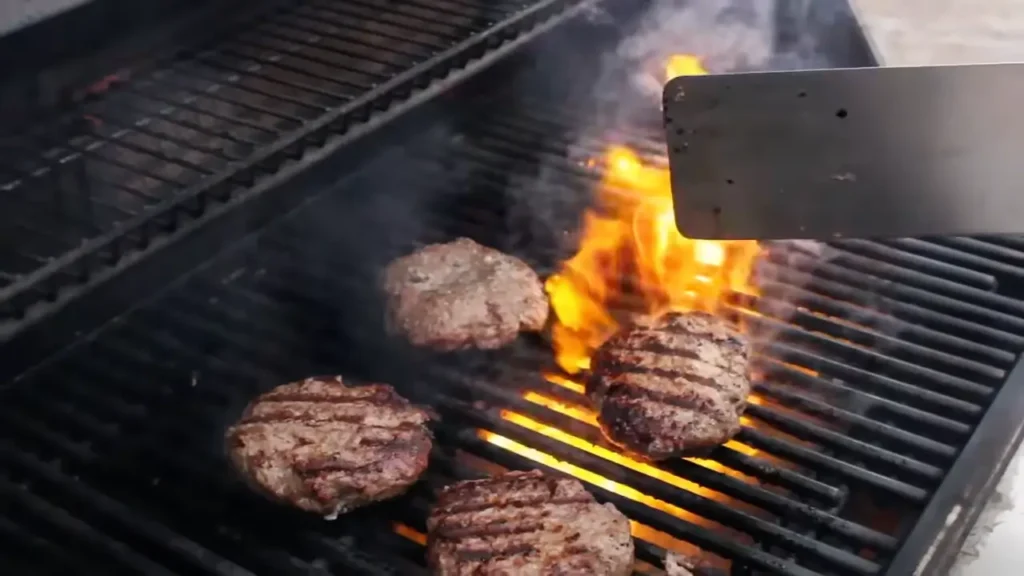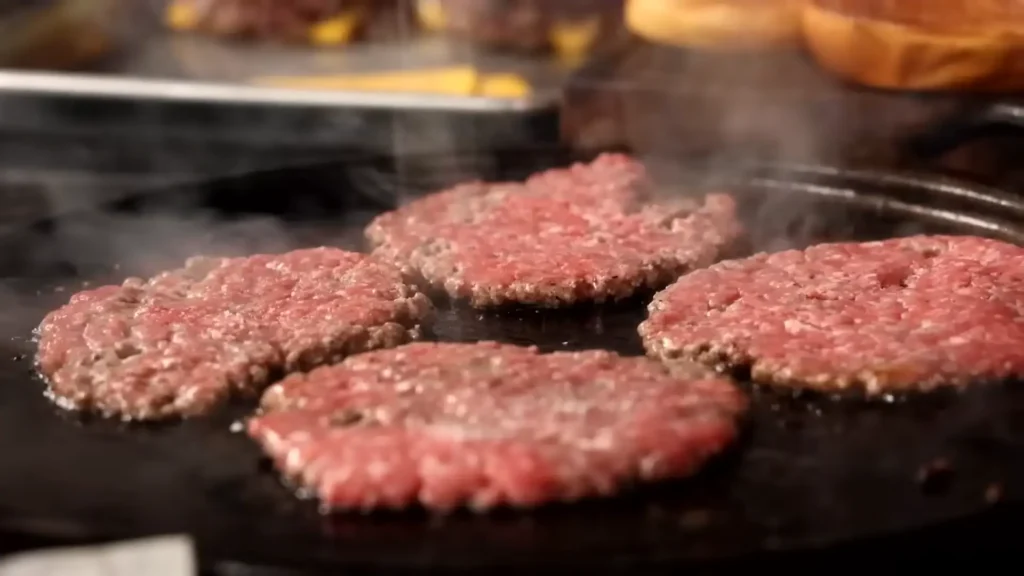I. Introduction to Grilling Burgers
grill burgers is a quintessential American tradition, especially popular during summer picnics and backyard barbecues. This cooking method not only imparts a unique flavor but also provides a versatile platform for a wide variety of tastes and preferences. This introduction will explore the fundamental aspects of grilling as a cooking method for burgers and highlight the importance of proper techniques to achieve delicious results.
A. Overview of Grilling as a Cooking Method for Burgers
Grilling involves cooking food on a grill over a heat source, typically charcoal or gas. When it comes to burgers, grilling them can enhance their flavor through the Maillard reaction and caramelization, which are chemical reactions that occur when proteins and sugars in the food are transformed by high heat, leading to complex flavors and aromas.
- Direct Heat Cooking: Burgers are commonly grilled over direct heat, meaning they are placed directly over the heat source. This method cooks burgers quickly, searing them to create a crispy, charred exterior while locking in juices.
- Flavor Enhancement: The intense heat of the grill helps to render the fat within the burgers, contributing to a juicy, flavorful patty. Smoke from the grill, especially when using charcoal or wood chips, adds a distinctive smoky flavor that is difficult to replicate with other cooking methods.
- Versatility: Grilling allows for adjusting the heat level (high for searing and low for cooking through), and the ability to easily add seasonings, marinades, and glazes that complement the natural flavors of the meat.
B. Importance of Proper Grilling Techniques for Delicious Results
The difference between a good burger and a great burger often lies in the grilling technique. Proper grilling techniques ensure not only the safety and doneness of the burgers but also enhance their taste and texture.
- Temperature Control: Maintaining the right temperature on a grill is crucial. A too-hot grill can burn the burgers, while a too-cool grill might lead to undercooking. The ideal grilling temperature for burgers is between 375°F to 400°F (medium-high heat).
- Handling the Patties: Minimizing the flipping of burgers during grilling is key; ideally, burgers should only be flipped once. Over-handling can cause the patties to fall apart or lose their juices.
- Doneness Testing: Knowing when burgers are perfectly cooked is vital. While some prefer using a meat thermometer (160°F for ground beef to ensure safety), learning to test doneness by touch or appearance is a skill that comes with practice.
- Resting the Meat: Allowing the burgers to rest for several minutes after grilling lets the juices redistribute throughout the patty, ensuring that each bite is moist and delicious.
II. Preparing Burger Patties
The secret to grilling the perfect burger lies in the preparation of the patties themselves. From selecting the right type of ground beef to properly seasoning and shaping the patties, each step plays a crucial role in the burger’s final flavor and texture. This section will guide you through these essential processes.
A. Choosing the Right Ground Beef
The choice of ground beef is foundational in determining the juiciness, flavor, and texture of the burger. Here are some tips to help you select the best ground beef for your burgers:
- Fat Content:
- Ideal Fat Percentage: Opt for ground beef with a fat content of around 15-20%. Beef labeled as 80/20 (80% lean meat and 20% fat) strikes a good balance between flavor and juiciness without being too greasy.
- Lean vs. Fatty: While leaner mixes like 90/10 are healthier, they tend to dry out if overcooked. Fattier mixes, such as 70/30, can be juicier but may shrink more due to fat rendering and can cause flare-ups on the grill.
- Beef Grade:
- Choice of Grade: Higher quality grades such as USDA Prime or Choice will have more marbling, meaning better flavor and tenderness.
- Ground Chuck, Round, or Sirloin: Ground chuck is preferred for burgers due to its richer flavor and ideal fat content. Ground round and sirloin are leaner options that are also popular.
- Freshness:
- Buy Fresh: Purchase beef that’s bright red in color and has a firm, cold texture. Avoid beef that has turned gray, as this indicates oxidation and staleness.
- Grind Your Own: For the freshest and most flavorful burgers, consider grinding your own beef at home. This allows for more control over the fat content and blend of cuts.
B. Seasoning and Shaping Burger Patties
Properly seasoning and shaping burger patties are pivotal for achieving the best grilled burgers:
- Seasoning the Meat:
- Salt and Pepper: At a minimum, generously season the beef with good quality salt and freshly ground black pepper. Salt the patties just before placing them on the grill to prevent them from drying out.
- Adding Flavors: For more complex flavors, consider incorporating garlic powder, onion powder, smoked paprika, or Worcestershire sauce into the meat. However, be cautious with liquid seasonings as they can affect the meat’s ability to hold together.
- Forming Patties:
- Patty Size: Aim for patties that are about ½ inch thick and wider than the bun, as they will shrink while cooking. A good rule of thumb is to form patties that are approximately 4-5 inches in diameter.
- Avoid Overworking: Handle the meat as little as possible when forming patties. Over-mixing can make the burgers tough and chewy once cooked.
- Make a Dimple: Press a shallow dimple into the center of each patty with your thumb. This helps the patty cook evenly and prevents it from puffing up in the center.
- Chilling:
- Refrigerate Before Grilling: Once formed, cover the patties and refrigerate for at least 30 minutes. This helps them hold their shape when placed on the hot grill.

III. Preheating the Grill
Preheating the grill is a critical step in the grilling process, especially when cooking burgers. This section discusses why it’s important to preheat your grill and provides specific tips for preheating both gas and charcoal grills effectively.
A. Importance of Preheating for Even Cooking
Preheating the grill ensures that the burgers cook evenly and achieve good sear marks, which are essential for flavor and appearance. Here’s why preheating is crucial:
- Ensures High Cooking Temperature: Preheating the grill allows it to reach the optimal temperature for cooking. This high heat is necessary for achieving a good sear on the burgers, which not only enhances their flavor through caramelization but also helps to lock in juices.
- Prevents Sticking: A hot grill grate reduces sticking. When the grate is sufficiently heated, the proteins in the meat don’t stick as easily, making flipping the burgers smoother and keeping them intact.
- Cooks Food Evenly: An adequately preheated grill provides a consistent heat source that cooks the burgers evenly on all sides, avoiding raw or overly charred spots.
B. Tips for Preheating Gas and Charcoal Grills
The method for preheating a grill varies slightly between gas and charcoal setups. Here’s how to do it effectively for each type:
For Gas Grills:
- Open the Lid: Start with the grill lid open to prevent gas buildup and to ensure safety.
- Turn on the Gas: Make sure your propane tank is open. Turn on the burners to full to start the gas flowing.
- Ignite the Grill: Use the ignition button if your grill has one. If your grill requires manual lighting, use a long lighter to safely ignite the burners from a distance.
- Close the Lid: Once the grill is lit, close the lid to trap the heat. This will help the grill reach cooking temperature more quickly.
- Preheat Time: Let the grill preheat for at least 10-15 minutes, or until it reaches a temperature of about 400-500 degrees Fahrenheit. Most gas grills have a built-in thermometer to monitor this.
- Clean the Grates: Once the grill is hot, use a grill brush to clean off any debris from the grates. This not only helps prevent sticking but also avoids off-flavors caused by charred buildup.
For Charcoal Grills:
- Prepare the Charcoal: Fill the grill base with charcoal briquettes (natural lump charcoal is preferred for its cleaner burn and better flavor).
- Light the Charcoal: Use a charcoal chimney starter for best results. Stuff the bottom with a few sheets of newspaper and the top with charcoal. Light the newspaper, and let the coals burn until covered with white-gray ash (about 15-20 minutes).
- Spread the Coals: Carefully pour the lit charcoal onto the grill base and use tongs to spread the coals out evenly. For burgers, distribute the coals in a single layer to provide consistent, direct heat.
- Preheat the Grate: Place the cooking grate on top and close the lid. Allow the grill to preheat for approximately 5-10 minutes. The goal is to get the grate hot enough to sear the burgers on contact.
- Clean the Grates: Brush the hot grates with a grill brush to clean off any residue from previous cooking sessions.
By properly preheating your grill, whether gas or charcoal, you ensure that it’s ready to cook the burgers with the right amount of heat. This not only optimizes the cooking process but also contributes significantly to the final taste and quality of the burgers. Preheating is a fundamental step that sets the stage for grilling success. Up next, we’ll dive into the techniques for grilling the burgers to achieve perfect doneness and delicious results.

IV. Grilling Techniques
Mastering grilling techniques is essential for cooking the perfect burger. This section explores the differences between direct and indirect grilling methods and discusses best practices for flipping burgers and maintaining an optimal grill temperature.
A. Direct vs. Indirect Grilling Methods
When grilling burgers, you can choose between direct and indirect grilling methods, each offering unique benefits depending on how you want your burger cooked.
Direct Grilling:
- Definition: Direct grilling involves cooking the food directly over the heat source. For burgers, this means placing the patties over the burners on a gas grill or directly over the coals on a charcoal grill.
- Temperature: Typically involves high heat (about 375°F to 400°F) to sear the burgers effectively.
- Cooking Time: Cooks quickly because of the high heat, making it ideal for achieving a crispy, charred exterior while keeping the inside juicy.
- When to Use: Best for cooking burgers that you want to sear with a smoky flavor and for when you’re looking for a quicker cook time.
Indirect Grilling:
- Definition: Indirect grilling means placing the food next to, not directly over, the heat source. This can be achieved by turning off one or more burners on a gas grill or by arranging the coals to one side of a charcoal grill and placing the food on the opposite side.
- Temperature: Utilizes a lower heat setting than direct grilling, allowing the burgers to cook slower and more evenly.
- Cooking Time: Takes longer than direct grilling, which can be beneficial for cooking thicker patties or making sure the inside is fully cooked without burning the outside.
- When to Use: Ideal for large, thick burgers or when you want to cook other foods on the grill at the same time without overcooking anything.
B. Flipping Burgers and Maintaining Grill Temperature
Properly flipping burgers and maintaining the right grill temperature are crucial for cooking them perfectly.
Flipping Burgers:
- One Flip Rule: Generally, burgers should only be flipped once during cooking. Wait until the juices are pooling on the surface of the burger and it releases easily from the grill, which indicates it’s ready to flip.
- Tools: Use a long-handled spatula for flipping to keep your hands away from the heat.
- Technique: Slide the spatula under the burger and lift it gently to flip. Avoid pressing down on the burger with the spatula as this can squeeze out juices and make the burger dry.
Maintaining Grill Temperature:
- Gas Grills: If using a gas grill, maintain a medium-high setting (around 375°F to 400°F) for direct grilling. Monitor the built-in thermometer to ensure it stays within this range. Adjust the burners as necessary to increase or decrease the heat.
- Charcoal Grills: For charcoal grills, keep an eye on the coals. If the temperature drops, you may need to add more coals. Use a grill thermometer to check the grill’s temperature. Manage the air flow using the grill vents; opening the vents will increase the heat, while closing them slightly will help maintain or reduce it.
- Adjustments: Both grill types may require slight adjustments based on factors like the weather (wind can cool the grill faster, for example) and how often the lid is opened (each opening lets heat escape).
Pro Tips:
- Pre-Warm the Grill: Before adding your burgers, let the grill preheat for at least 10-15 minutes. A properly heated grill sears burgers on contact, preventing sticking and ensuring a well-formed crust.
- Recovery Time: After flipping the burgers, allow the grill a couple of minutes to return to the correct temperature before making any further adjustments.
By understanding and applying these grilling techniques, you can ensure your burgers are cooked to perfection, with a delicious charred exterior and a juicy interior. The choice between direct and indirect grilling methods and the proper flipping and temperature maintenance strategies will greatly influence the final quality of your burgers. In the next section, we will explore additional tips for enhancing burger flavors and ensuring they are served at their best.
FAQs
- Question: How long do you cook burgers on a grill?
Answer: Cook burgers for about 4-5 minutes per side for medium-rare, or until an internal temperature of 160°F (71°C) is reached. - Question: Should you grill burgers on high or medium heat?
Answer: Grill burgers on medium heat to ensure even cooking without burning the exterior. - Question: Should you grill burgers with lid open or closed?
Answer: Close the lid while grilling burgers to trap heat and cook them evenly, flipping occasionally. - Question: Do you grill burgers directly over flame?
Answer: Avoid grilling burgers directly over flames to prevent flare-ups and charring. Opt for indirect heat for better results.

